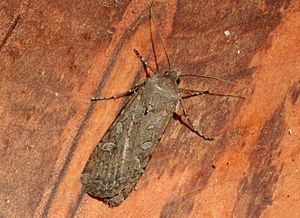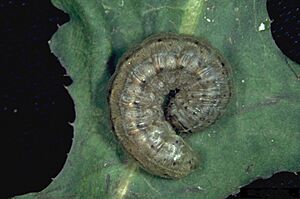Army cutworm facts for kids
Quick facts for kids Army cutworm |
|
|---|---|
 |
|
| Scientific classification | |
| Kingdom: | |
| Phylum: | |
| Class: | |
| Order: | |
| Family: | |
| Tribe: |
Agrotini
|
| Genus: |
Euxoa
|
| Species: |
E. auxiliaris
|
| Binomial name | |
| Euxoa auxiliaris (Grote, 1873)
|
|
The army cutworm is the young form of a moth called Euxoa auxiliaris. People often call the adult moth a "miller moth." This is because its wings have tiny scales that rub off easily. These scales remind people of the dusty flour that covers a miller's clothes.
Contents
What is an Army Cutworm?
Army cutworms are native to North America. They are the larvae, or young, of the miller moth. These larvae eat many different plants. They feed on young grains, alfalfa, and canola in the southern Great Plains and southern Canada.
During the day, these larvae usually hide in the soil. They come out to feed at night. On cloudy days, they might also feed during daylight hours.
Where Do They Live and What Do They Eat?
In the dry, low-lying areas of the U.S. Intermountain West, army cutworms eat plants like cheatgrass and mustards. Sometimes, they eat so much cheatgrass that it creates bare spots in the land. They also eat native shrubs such as four-wing saltbush and sagebrush.
The adult miller moths are very common in the Western United States and its prairies. They are known to travel to alpine climate regions. These are high, cool mountain areas. They go there in late June and early July. In these mountains, they feed on the sweet liquid, called nectar, from wildflowers at night.
Amazing Migrations
Miller moths are a common sight in the spring in states like Colorado, Wyoming, New Mexico, and Kansas. They hatch in the low-lying farmlands. Then, they migrate to higher, cooler places for the summer. When the weather gets cooler, they fly back. However, fewer moths return in the fall.
It is very hard to control these moths with normal pest methods. This is because new groups of moths arrive every day as they migrate. Their small bodies allow them to enter homes easily. They are attracted by lights in the evening. They can get in through tiny cracks around doors or chimneys. People living in their migration paths might see dozens of moths entering their homes daily. Even though they can be a bother, they are not considered harmful.
Why Are They Important?
Army cutworms are a very important food source for predators. For example, brown bears eat them in their mountain homes. These moths are incredibly rich in fat. Up to 72 percent of a miller moth's body weight can be fat. This makes them more calorie-rich than animals like elk or deer. In fact, it is the highest known body fat percentage of any animal!


